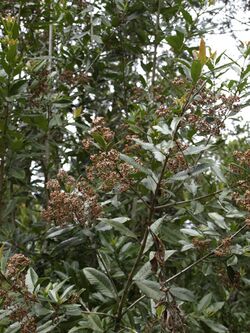Biology:Caldcluvia
| Tiaca | |
|---|---|

| |
| Scientific classification | |
| Kingdom: | Plantae |
| Clade: | Tracheophytes |
| Clade: | Angiosperms |
| Clade: | Eudicots |
| Clade: | Rosids |
| Order: | Oxalidales |
| Family: | Cunoniaceae |
| Genus: | Caldcluvia D.Don |
| Species: | C. paniculata
|
| Binomial name | |
| Caldcluvia paniculata (Cav.) D.Don
| |
| Synonyms[1] | |
| |
Caldcluvia is a monotypic genus in the family Cunoniaceae with the only species Caldcluvia paniculata, known as tiaca, an evergreen tree native to Chile . It is found from Ñuble to Aisén (36 to 45°S). Most species that were previously placed in the genus are now placed in Ackama, Opocunonia and Spiraeopsis.
Description
Caldcluvia paniculata can grow up to 20 m (65 ft) in height[2] and up to 60 cm (24 in) in diameter. The bark is grayish brown. The leaves are oppositely arranged, toothed edge, oblong and lanceolate shaped. 7-15 long, 2–4 cm wide, with the apex and base acute. Glossy green above and whitish and somewhat hairy below, the petioles are fluted and hairy about 0-7-1 cm long. The white flowers clustered in axillary peduncles are hermaphrodite, peduncles and pedicels are hairy, 4-5 hairy sepals and more or less imbricate, 4 –5 petals alternate to the sepals. 8-10 stamens, 2 styles. The fruit is an acuminate capsule, hairy and crowned by persistent styles, inside them there are dark brown seeds about 1 mm long.
The tree requires wet climate, tolerates up to 40% shade, and may need partial shade in some locations. It is classified in USDA Hardiness Zone 9. Germination from seeds is less than 30%.
Taxonomy
Caldcluvia was named after Scottish botanist Alexander Caldcleugh, who travelled to South America between 1819–1825; he collected plants for Royal Botanic Gardens, Kew in England .[3] (As of April 2021), Plants of the World Online accepted only one species, Caldcluvia paniculata.[4] The epithet paniculata, or panicled, means "with panicles".[5]
Cultivation and uses
The leaves are used as herbal tea for the treatment of colds and stomach disorders. It has been planted in Northern Ireland.[6]
References
- ↑ The Plant List: A Working List of All Plant Species, http://www.theplantlist.org/tpl1.1/record/kew-2691759, retrieved 21 August 2016
- ↑ "Caldcluvia paniculata (Cav.) D. Don". Chileflora. http://www.chileflora.com/Florachilena/FloraEnglish/HighResPages/EH0112.htm. Retrieved 2018-05-09.
- ↑ "Alexander Caldcleugh". https://historyarchive.org/works/creators/alexander-caldcleugh.
- ↑ "Caldcluvia D.Don". Plants of the World Online. Royal Botanic Gardens, Kew. https://powo.science.kew.org/taxon/urn:lsid:ipni.org:names:36971-1.
- ↑ Gledhill, David (2008). "The Names of Plants". Cambridge University Press. ISBN:9780521866453 (hardback), ISBN:9780521685535 (paperback). pp 206, 289.
- ↑ "Seaforde Gargens Plant Catalogue". Seaforde Estate Company. http://www.seafordegardens.com/resources/catalogue.pdf. Retrieved 2010-04-01.
External links
- "Caldcluvia paniculata". Enciclopedia de la Flora Chilena. http://www.florachilena.cl/Niv_tax/Angiospermas/Ordenes/Oxidales/Cunoniaceae/Caldcluvia/Tiaca.htm. Retrieved 2010-03-28.
- "Caldcluvia paniculata". Chilebosque. http://www.chilebosque.cl/tree/cpani.html. Retrieved 2010-03-28.
- "Caldcluvia paniculata". Patagonian plants. http://www.patagoniaplants.com/products/trees/caldcluvia-paniculata/detailed-product-flyer.html. Retrieved 2010-04-01.
Wikidata ☰ {{{from}}} entry
 |

